Abstract
Sweet sorghum juice, a potential bioethanol feedstock, can be incorporated into the dry-grind ethanol process to improve sugar utilization efficiency, thereby enhancing ethanol yields. The juice is normally obtained by pressing the stalk through roller mills in tandem. Juice extraction by this process is known to be labor intensive, less efficient, and susceptible to considerable fermentable sugar loss due to microbial activities when stored at room temperature. Sweet sorghum juice extraction via diffusion has recently been proposed to improve sugar recovery efficiency. In this study, extraction kinetics based on the optimized diffusion parameters (8% grain loading, 85 °C, and 120 min) were determined to describe the mass transfer of sugars in sweet sorghum biomass during the diffusion process. Diffusion parameters obtained from previous studies were used to extract free sugars and convert them into ethanol using granular starch hydrolyzing enzymes (GSHE) and traditional enzymes. Ethanol yields at 72 h of fermentation mashes treated with GSHE and those with traditional enzymes were comparable (14.49–14.56%, v/v). Ethanol fermentation efficiencies also ranged from 88.92–92.02%.
1. Introduction
Sweet sorghum juice can be directly converted into bioethanol via anaerobic fermentation by yeast Saccharomyces cerevisiae [1,2,3,4]. The fermentable sugars in the juice can also be utilized as raw material for the industrial production of lactic acid by Lactobacillus sp. [5], acetone-butanol by Clostriduim acetobutylicum [6], and the production of other organic acids [7]. Ethanol fermentation efficiencies from sweet sorghum juice also range from 85 to 93% [1,8,9]. However, a recent study showed that a combination of juice and starch from the grains in sweet sorghum improved ethanol yields by nearly 30% while reducing the starch enzymatic hydrolysis time by 30 min as compared to the conventional process [8]. Another study also reported that co-fermenting corn starch with sweet sorghum juice resulted in a 37% reduction in the quantity of corn required in the dry-grind process [10].
The juice from the sweet sorghum stem is normally extracted by 2- or 3-roller mills in tandem following harvesting and stripping of the leaves [11,12,13]. During the harvesting process, the pinnacle is chopped and left on the field, thus a significant amount of starch (63–73%) that could be processed into ethanol is lost. The juice extraction with this process is usually less efficient but could be up to 54.6% [7,14,15,16]. Low juice extraction yield could be attributed to the relatively high fiber content of sweet sorghum juice. Additionally, juice obtained is not stable because about 50% of the fermentable sugars could be lost when stored at room temperature due to microbial activities [1].
The diffusion process has been recently shown as an alternative and innovative method of obtaining both nonstructural and fermentable sugars from sweet sorghum feedstock [17]. Diffusion is defined as “the net transfer of matter from a region of high concentration to that of low concentration”, which is due to thermal molecular movement until state of equilibrium is reached (i.e., state of uniform concentration) [18]. In the sugarcane industry, diffusers have been operational since before the 19th century [16]. In this process, the feedstock is hammer-milled to uniform particle sizes and then passed through a series of continuous hot water flushes in which the concentration of solute is cocntinuously reduced [19]. Sweet sorghum has a similar physiological structure to sugarcane and could allow the use of the same harvesting and transportation equipment used in the sugarcane infrastructure [20]. Furthermore, sweet sorghum has a very short season and therefore can be grown during the fallow period between stands in sugarcane production. Moreover, since the harvest periods of both crops overlap, sweet sorghum could be integrated in the existing sugarcane industry [21]. The integration of the sweet sorghum starch in the diffusion process via enzymatic hydrolysis could, as well, improve the overall fermentable sugar extraction from the energy crop.
Few studies have been reported on the kinetics of extraction of sugars from sugar crops. El-Belghiti and Vorobiev [22] investigated the extraction of sugars from slices of sugar beet (30 mm in diameter and 8.5 mm in thickness) by applying pulsed electric field treatment at room temperature. Jemai and Vorobiev [23] also reported a study on the effect of moderate electric field pulse on the diffusion coefficient of sugars from apple slices. The mass transfer kinetics of sugars from chopped sweet sorghum stalks (2–16 mm) for solid-state fermentation process has recently been published [24]. However, no study has been conducted on the mass transfer kinetics of fermentable sugars from ground sweet sorghum biomass for ethanol production.
A previous model study of fermentable sugar extraction and starch hydrolysis from sweet sorghum bagasse and grain flour via diffusion process showed the increase of sugar diffusivity from the sweet sorghum feedstock [17], but the mass transfer kinetics of the sugar molecules were not studied. Appiah-Nkansah et al. [17] applied the Box-Behnken design in response surface methodology (RSM) to optimize diffusion conditions to achieve the highest fermentable sugars from sweet sorghum. The RSM is a set of statistical and optimization techniques aimed at optimizing quality characteristics of a production process and product [25].
In this research, the mass transfer kinetics of sugar extraction from sweet sorghum biomass, based on the RSM optimized parameters from the previous study, was investigated to fill existing gaps in the literature of sweet sorghum biomass. Additionally, the optimized diffusion conditions obtained in the previous study were also applied to extract sugars and hydrolyze starch from sweet sorghum feedstock. This was followed by a study of the ethanol fermentation performance using both traditional enzymes and granular starch hydrolysis enzymes (GSHE) Stargen 002. The GSHE consists of both alpha-alymase and gluco-amylase that have a synergistic effect on the hydrolysis of granular starch to glucose. The utilization of GSHE in the ethanol process can eliminate the need for high temperature (>80 °C) cooking during the starch hydrolysis and liquefaction stage thus reducing energy input [8,26,27].
2. Materials and Methods
2.1. Materials
Sweet sorghum grain and dried bagasse were obtained from Texas A&M University, College Station, Texas. The feedstock was prepared following the method described in Appiah-Nkansah et al. [17]. GSHE (Stargen™ 002) was obtained from Genencor International (Palo Alto, CA) with an activity of 570 GAU/g (where GAU = one glucose unit) and specific gravity of 1.13–1.16 g/mL. Alpha-amylase (Liquozyme® SC DS) and gluco-amylase (Spirizyme) were obtained from Novozymes (Franklinton, NC). Liquozyme® SC DS (alpha-amylase) has an activity of 267 KNU/g, (where KNU = kilo novo α-amylase units) and a specific gravity of 1.266 g/mL. Spirizyme® Achieve (gluco-amylase) has an activity of >900 AGU/g and a specific gravity of 1.161 g/mL.
2.2. Starch Content and Moisture Content Analysis
The starch content of the sorghum grain was analyzed using a total starch kit (Megazyme International) following an accepted method [28]. Moisture content of the materials was determined using standard American Association of Cereal Chemists (AACC) and National Renewable Energy Laboratory (NREL) methods [29,30,31].
2.3. Kinetic Model Study
Extraction of sugar molecules from the biomass is considered to be a mass transfer process of sugar solutes migrating from the inside of the fractured cell by diffusion into a bulk solution. The following first-order kinetic equation [32] was applied to study the kinetics of sugar transfer from sweet sorghum biomass:
where is the solute concentration in the solution at any time point during the extraction process; is the equilibrium solute concentration; , is the final concentration due to diffusion, (min−1) is the rate constant for the diffusion stage.
2.4. Sugar Extraction
Batch extractions were performed in a Parr reactor (Parr Instrument Co., Moline, IL, USA) operated in a horizontal mode. For each experiment, 40 g of biomass (grain + bagasse) was used. An amount of 8.8 g of sweet sorghum grain flour representing 22.02% of biomass and 31.2 g of sweet sorghum bagasse (77.98% of the biomass) was weighed in a 500 mL beaker. Approximately 750 mL of distilled water was preheated for 5 min and 500 mL of preheated water was measured. Approximately 400 mL of the preheated water was poured into the 1 L reaction vessel of the Parr pressure reactor, and the biomass sample was added. The reactor is equipped with impeller mixers and a controlled heating system. The remaining ~100 mL was used to thoroughly rinse the beaker into the reaction vessel. Thirty microliters of Liquozyme® SC DS (alpha-amylase 267 KNU/g, 1.266 g/mL) was added to the content. The reaction vessel was then coupled to the Parr reactor assembly, oriented in horizontal position (Figure 1), and set to run for 120 min at a set temperature of 85 °C and an impeller speed of 100 revolutions per minute (rpm). The heating source was removed and the reactor was cooled to a temperature below 50 °C. The vessel was disengaged and 150 mL of Spirizyme® Achieve (glucoamylase > 900 AGU/g, 1.161 g/mL) was added to the mixture. The vessel was fixed again to the Parr reactor system, set to run for 40 min at a temperature of 60 °C, and then the slurry was recovered. Recovered slurries were centrifuged in order to separate out the solid portions using by a Sorvall RC 6+ Centrifuge (Thermo Fisher Scientific, Asheville, NC, USA). The liquid potion which contained dissolved free sugars were utilized as solvent for the next batch process as previously described for 4 addition runs.
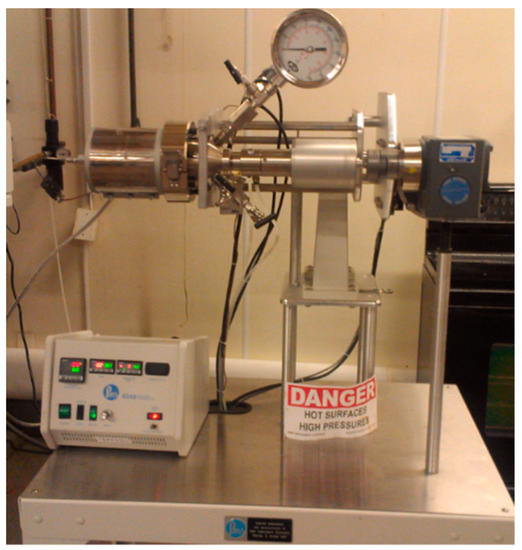
Figure 1.
Stirred Parr reactor operating in horizontal positon.
2.5. Sugar and Ethanol Analysis
Components were analyzed by a high performance liquid chromatography (HPLC) with a Rezex RCM Monosaccharide (300 × 7.80 mm) and a Refractive Index Detector RID—G1362A (Agilent Technologies, Santa Clara, CA, USA). Twenty microliters of the sample were injected with the mobile phase (HPLC-grade deionized water). The mobile phase with the analytes was pumped at a high pressure of 33–42 bar into a column packed with monosaccharides calcium ions. The elution rate was maintained at 0.6 mL/min and a column temperature of 80 °C. Components (i.e., sugars, ethanol, and organic acids) separated in the column were detected with a refractive index detector and quantified. The theoretical ethanol yield was determined using the total starch contents in the samples, assuming 0.568 g ethanol from 1 g of starch. Fermentation efficiencies were calculated as the actual ethanol yield divided by the theoretical ethanol yield.
2.6. Inoculum Preparation
Dry yeast was activated by adding 1.0 g of active dry yeast into 19 mL of preculture broth (containing 20 g of glucose, 5.0 g of peptone, 3.0 g of yeast extracts, 1.0 g of KH2PO4, and 0.5 g of MgSO4·7H2O per liter) and incubated at 38 °C for 30 min in an incubator operating at 200 rpm. The activated yeast culture had a cell concentration of 1 × 109 cells/mL.
2.7. Ethanol Fermentation
Three treatments of the extracted solutions were prepared for the ethanol fermentation process—extracted solution only (“Juice only”), extracted solutions combined with grain sorghum flour using conventional enzymes (“Traditional”), and extracted solution combined with grain flour using GSHE (“GSHE”). Cleaned grain sorghum samples were milled into flour through a 0.5 mm screen in an Udy cyclone mill (Udy Corp., Fort Collins, CO, USA) and used for ethanol fermentation.
One hundred milliliters of extracted sugar solutions were weighted into 250 mL Erlenmeyer flasks and supplemented with 0.3 g of yeast extract per flask. After adjusting the pH value to 4.2 with 2N hydrochloric acid, the sample was incubated with 1.0 mL freshly activated dry yeast (Ethanol Red) and 100 μL of Spirizyme at 30 °C for 72 h in a 12,400 Incubator Shaker (New Brunswick Scientific Co. Inc., Edison, NJ, USA) operating at 150 rpm. For conventional enzyme treatment, fifteen grams (dry base) of ground sorghum (60% starch content) was mixed with 100 mL of preheated (about 60 °C) extracted juice containing 0.1 g of KH2PO4 and 20 μL of Liquozyme (alpha-amylase, Novozymes, Franklinton, NC, USA) to form an evenly suspended mash. For starch liquefaction, the flask was transferred to a 70 °C water-bath shaker operating at about 180 rpm. The temperature of the water bath was gradually increased from 70 to 90 °C in a 30 min period, kept at 90 °C for a few minutes, and then lowered to 85 °C and kept for 60 min. The flask was then removed from the water bath, and materials sticking on the inner surface of the flask were pushed back into the mash with a spatula. The spatula and inner surface of the flasks were rinsed with 3–5 mL of distilled water. After cooling to room temperature (25 to 30 °C), the pH of the mashes was adjusted to around 4.2 with 2M HCl for the fermentation process. For the GSHE treatment, 15 g of grain sorghum flour (dry basis) was weighed into a 250 mL clean Erlenmeyer flask. One hundred milliliters of warm (about 60 °C) extracted sugar solution was also poured into the flasks and mixed to form an evenly suspended mash. The mash was then treated with 60 μL granular starch (Stargen 002), carefully transferred into a 48 °C water-bath shaker, and set to operate at 180 rpm for 2 h. The pH was adjusted to 4.2 by the same procedure previously described.
The separate saccharification and fermentation (SSF) process started with the addition of 1.0 mL of the activated yeast culture, 100 μL of Spirizyme, (750 AGU/g, about 1.15 g/mL) (Novozymes, Franklinton, NC, USA), and 0.30 g of yeast extract into mashes in each flask. Flasks were sealed with an S-airlock with mineral oil. Fermentation was conducted at 30 °C for 72 h in an incubator shaker operating at 150 r/min. Fermentation performance was monitored by weighing the fermentation flasks for a 3-day incubation period at 4, 8, 18, 24, 32, 44, 56, and 72 h of fermentation. The weight loss was due to the evolution of CO2 during the fermentation process (C6H12O6 → 2C2H6O + 2CO2↑).
2.8. Statistical Analysis
Statistical analyses were performed by using Microsoft® Excel® 2013. Matlab R2013a was used to develop an extraction kinetic model graph. Final ethanol yields and efficiencies were compared using analysis of variance in SAS 9.4 at 0.05 level (p < 0.05) statistical significance. Fermentation experiments were performed at least in duplicate.
3. Results and Discussion
3.1. Kinetic Study of Sugar Transfer from Sweet Sorghum Biomass via Diffusion
An illustration of sugar transfer by thermal movement from the interior of the ruptured cells and through the thin cell membrane into the bulk solution is presented in Figure 2. The transfer of sugar molecules is driven by concentration gradient from the high concentrated region into the low concentration region according to Fick’s law of diffusion [18,22,33]. The purpose of kinetic study is to describe parameters for predicting the entire mass transfer curve to aid in process design and also for assessing the feasibility of the process in the industry [33].
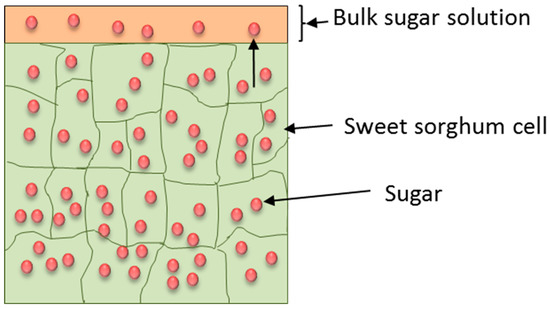
Figure 2.
A schematic diagram of the structure of sweet sorghum indicating the transfer of sugar from the interior cell plant cell into the bulk solution.
In this work, the extraction kinetics of sugars from the sweet sorghum biomass were analyzed based on the RSM model (Equation (2)), from the previous study [17]. It is important for kinetic study to know the effects of process variables such as temperature, solid/solvent ratio, and so on, on extraction performance [24,33]. The parameters of time, temperature, and grain/biomass loading ratio, significantly influenced sugar extraction in the previous study. These optimized parameters were used to predict the total curve of sugar extraction and to understand the delineation of the sugar transfer process via diffusion. The developed model was transformed into the first-order kinetic equation expressed in Equation (1). The RSM model was described in coded form in Equation (2):
where, represent exaction variables: time, temperature, and solid content, respectively. This can be converted into an equation using the natural or actual experimental variables by substitution based on the relation:
where xi is the coded value of the ith independent variable, Xi is the actual value of the ith independent variable, is the actual ith independent variable at the center point, and is the step change value. The equation in terms of the actual factors becomes
The simplified equation then becomes:
When , , and
When , = 75, and
Based on Equations (6) and (7), = 0.033 min−1, , Then
The kinetic model describing the mass transfer of sugar molecules from biomass into the solution was represented by the following equation:
The kinetic model curve which displayed the mass transfer dynamics of sugar molecules during diffusion is shown in Figure 3. It was observed that the concentration of the sugar molecules changed with time during the sugar extraction process. The profile of the graph showed rapid transfer of sugar solutes from the biomass into the solvent occurred at the beginning of the process and during the first 80 min. Up to 95% sugar was transferred from the biomass into the solvent. The sugar extraction rate then gradually decreased during the following 20 min, until it drastically slowed down and became constant, corresponding to maximum yield and reaching equilibrium after about 115 min. The quick transfer of sugar at the initial stage was attributed to a high concentration gradient at the beginning of the process. A similar extraction kinetics behavior of rapid transfer of solutes at the beginning of the process with time was observed during the extraction of olive oil [34] and soybean oil [33,35], using ethanol as solvent; and canola oil, sunflower oil, and jojoba oil, using hexane [36,37,38,39]. Toda et al. [33] examined the kinetics of soybean oil and free fatty acids extraction from soybean collets at varying temperature levels. Oil transfer from the soybean into the solvent was faster at the initial stages, and then decreased until equilibrium was reached. Mao et al. [24], recently, studied the mass transfer of sugar in sweet sorghum stalks of different particle sizes (2, 4, 6, 12, and 16 mm) over a temperature range of 20–60 °C for solid state fermentation. Sugar transfer in smaller particles reached equilibrium faster because shorter time was needed, due to the increased surface area available for extraction and decreased mass transfer distance. Additionally, increasing temperature also enhanced the rate of extraction. Sugar extraction from 2 mm particle sizes at 60 °C reached equilibrium after 150 min into the extraction process. In this study, the migration of sugar sweet sorghum feedstock (milled through 3.99 mm at screen) at 95 °C reached equilibrium at a relatively faster rate (after 115 min), which was attributed to the higher extraction temperature. Toda et al. [33] also observed an increased rate of oil transfer from the solid matrix with increased temperature. Higher mass transfer may also be achieved by the convective currents of the bulk fluid in motion [40]. Increasing stirring speed facilitated the rate of extraction [24]. In the present model study, stirring speed was maintained at 100 rpm with the Parr reactor tilted to the horizontal potion (Figure 1), ensuring rapid transfer of sugars from the solid matric into the bulk solution. Thus, high temperature plus stirring increased the random movement and solubility of sugar molecules in diffusion.
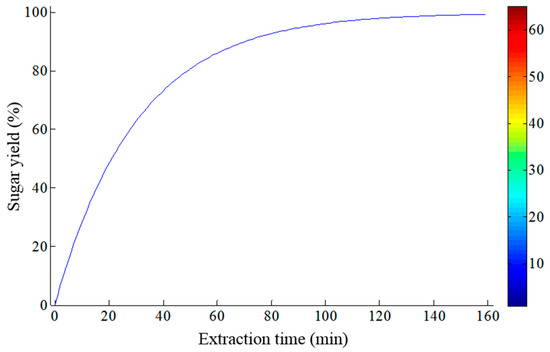
Figure 3.
Kinetics of extraction of sugar from sweet sorghum biomass (color code indicates the concentration of sugars in the bulk solution (g/L)).
3.2. Sugar Yields
It is important to note that the sweet sorghum bagasse used in this work had been previously stored in a container at room temperature for more than one year, hence, it is expected that some free sugars might have been lost over the storage period. Nevertheless, we investigated the amount of sugars that could be extracted from the feedstock by applying the diffusion method. In this work, continuous extraction was achieved by centrifuging sugar solution obtained from the first run solvent for second run as the extraction and this process was repeated for the subsequent runs. After each run, 0.2 mL of the centrifuged solutions was taken for HPLC analysis. Figure 4 and Figure 5 represent the total sugars extracted from the sweet sorghum feedstock and the efficiencies, respectively. The results showed a strong quadratic relationship between total sugars and the number of runs and fitted the data very well with R2 being greater than 0.99 (R2 = 0.9987). Sugars released ranged from 3.56 to 14.24 g/L over with corresponding efficiencies of 91.1–64.4%. In this work, extracted sugar solutions were used as solvents for subsequent runs, resulting in increasing sugar concentrations in the subsequent runs, which might have reduced the rate of mass transfer of sugar molecules from the sugar cells into the solvent, hence the decreasing extraction efficiencies observed. Based on the outcome, the total sugars and the extraction efficiency could be related to number of runs by the following second order equations:
where , , and represents the total sugars, extraction efficiency, and number of runs, respectively.
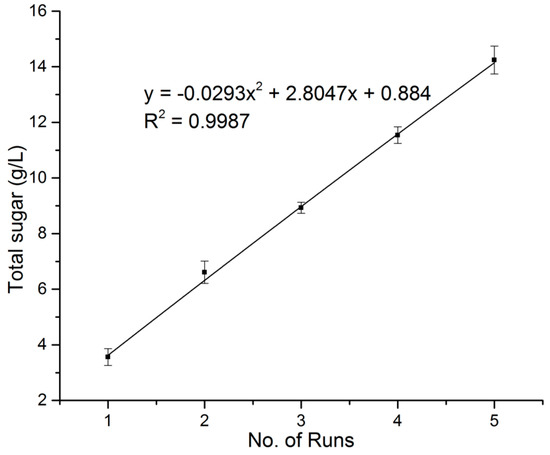
Figure 4.
Effect of extraction times on sugar concentrations.
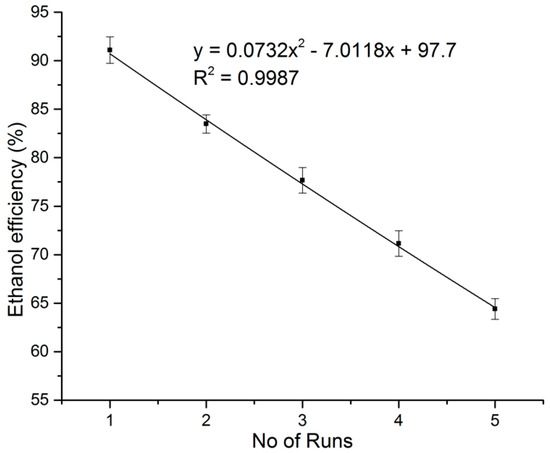
Figure 5.
Effect of extraction times on sugar extraction efficiency.
3.3. Ethanol Fermentation Yield and Efficiencies
Ethanol yield performance and efficiencies of extracted sweet sorghum juice only and juice with sorghum grain flour with and without hydrolysis are represented in Figure 6 and Figure 7, respectively. The ethanol fermentation profile for the treatment was comparable during the first 40 h of the process. Similar observations were reported by Appiah-Nkansah et al. [8]. Ethanol yield for “Juice only” was complete around 40 h and remained constant towards the end. From 32 to 68 h, ethanol concentrations of “GSHE” were slightly higher compared to “Traditional”. The final ethanol yield at 72 h of the “Traditional” was 14.56 % (v/v) and that of “GSHE” was 14.49% (v/v) (Figure 6). It is important to note that GSHE used in this study contains Aspergillus kawachi alpha-amylase expressed in Trichoderma reesei and a gluco-amylase from Trichoderma reesei. Gohel and Duan [41] examined low temperature hydrolysis for (25% dry solids) Indian broken rice (68.45% starch content) and pearl millet (60% starch content) using GSHE, along with acid fungal protease (Fermgen) under yeast fermentation conditions. The acid fungal protease was utilized to digest protein in the grains into amino acids, peptides, and free amino nitrogen for yeast vitality. They obtained 11–12% (v/v) and 9–10% (v/v) from Indian broken rice and Indian pearl millet, respectively. Fermentation efficiencies also ranged from 97 to 98% in both feedstocks compared to 81–90% fermentation efficiency observed in the conventional process. Wang [42] also compared the fermentation process from corn mashes (25% dry solids content) of using, Stargen 001, a raw starch hydrolyzing enzyme with conventional enzymes and reported similar ethanol yields of 14.1–14.2% (v/v). The ethanol fermentation profiles of samples treated with the Stargen 001 were also comparable to those treated with conventional enzymes. Genencor International (Palo Alto, CA, USA), the manufacturers of Stargen 002, reported slightly above 10% (v/v) of ethanol from corn (28% dry solids) from Stargen 002 [43]. No difference (p < 0.05) in the final ethanol yields and efficiencies observed among the two enzyme treatments. The conversion efficiencies obtained in this study ranged from 88.92–92.02% (Figure 7). The high ethanol fermentation efficiency of “Juice only” (92.02%) obtained in the work, was anticipated because broths with lower sugar concentrations would have higher fermentation efficiency if the same amount of yeast and nutrients were used for ethanol conversion from sugars [8,27]. Ethanol yields and efficiencies reported by Appiah-Nkansah et al. [8] from mashes of sweet sorghum juice with varying grain sorghum flour samples using Stargen 002 ranged from 10.73 to 16.70% (v/v) and 87.66 to 94.65% (v/v), respectively.
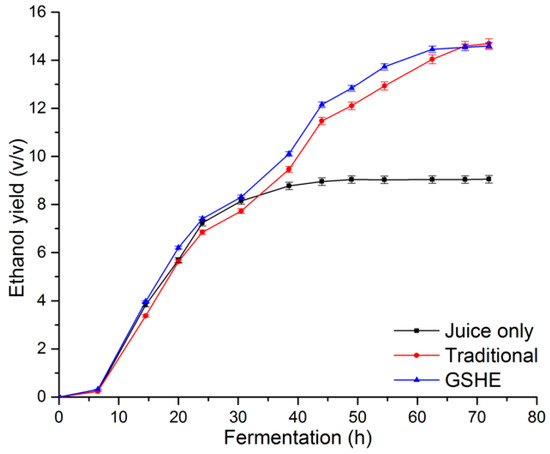
Figure 6.
Ethanol fermentation yield of juice only and juice plus sorghum grain flour with (Traditional) and without (granular starch hydrolyzing enzymes (GSHE)) hydrolysis.
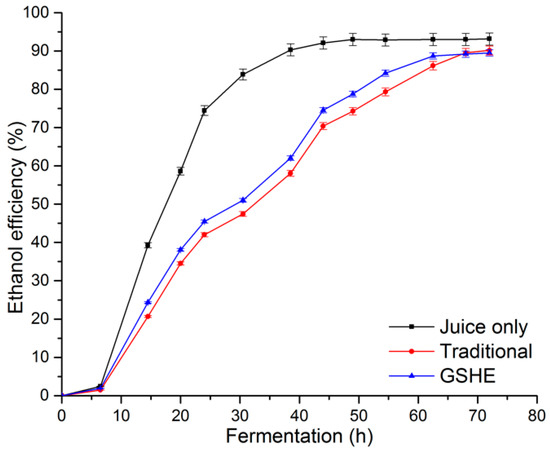
Figure 7.
Ethanol conversion efficiency of juice only and juice plus sorghum grain flour with (Traditional) and without (GSHE) hydrolysis.
4. Conclusions
In this study, a model for describing the kinetics of sugar transfer from sweet sorghum biomass via diffusion was developed. The diffusion conditional parameters were applied to extract free sugars and non-structural carbohydrates from sweet sorghum feedstock. Sugar transfer from sweet sorghum biomass reached equilibrium at a faster rate with a higher extraction temperature of 95 °C There was a strong quadratic relationship between total diffusion runs and sugars extracted, as well as extraction efficiencies. The ethanol fermentation process using GSHE was compared with conventional enzymes for extracted sugars combined with grain sorghum flour. This work demonstrated that GSHE could be utilized as an energy-conserving alternative process for bioethanol conversion of sweet sorghum juice feedstock.
Author Contributions
Conceptualization and program writing: M.Z. and D.W.; data collection and analysis: N.B.A.-N., J.L., and K.Z.; writing—original draft preparation: N.B.A.-N. and J.L.; writing—review and editing: D.W.
Funding
This work was supported by United Sorghum Checkoff Program with grant number of RN004-14.
Acknowledgments
This publication is contribution no. 17-046-J from the Kansas Agricultural Experiment Station, Manhattan, KS 66506-0210.
Conflicts of Interest
The authors declare no conflict of interest.
References
- Du, R.; Yan, J.; Feng, Q.; Li, P.; Zhang, L.; Chang, S.; Li, S. A novel wild-type Saccharomyces cerevisiae strain TSH1 in scaling-up of solid-state fermentation of ethanol from sweet sorghum stalks. PLoS ONE 2014, 9, e94480. [Google Scholar] [CrossRef] [PubMed]
- Phutela, U.G.; Kaur, J. Process Optimization for Ethanol Production from Sweet Sorghum Juice Using Saccharomyces cerevisiae Strain NRRL Y-2034 by Response Surface Methodology. Sugar Tech 2014, 16, 411–421. [Google Scholar] [CrossRef]
- Wu, X.; Staggenborg, S.; Propheter, J.L.; Rooney, W.L.; Yu, J.; Wang, D. Features of sweet sorghum juice and their performance in ethanol fermentation. Ind. Crop. Prod. 2011, 31, 164–170. [Google Scholar] [CrossRef]
- Wu, X.; Staggenborg, S.; Wang, D. Stabilization of sweet sorghum juice for long-term storage. Trans. ASABE 2015, 58, 169–175. [Google Scholar]
- Hetényi, K.; Gál, K.; Németh, Á.; Sevella, B. Use of sweet sorghum juice for lactic acid fermentation: Preliminary steps in a process optimization. J. Chem. Technol. Biotechnol. 2010, 85, 872–877. [Google Scholar] [CrossRef]
- Cheng, Y.; Li, S.; Huang, J.; Zhang, Q.; Wang, X. Production of acetone and butanol by fermentation of sweet sorghum stalk juice. Trans. CSAE 2008, 24, 177–180. [Google Scholar]
- Whitfield, M.B.; Chinn, M.S.; Veal, M.W. Processing of materials derived from sweet sorghum for biobased products. Ind. Crop. Prod. 2012, 37, 362–375. [Google Scholar] [CrossRef]
- Appiah-Nkansah, N.B.; Saul, K.; Rooney, W.; Wang, D. Adding sweetsorghum juice into the current dry-grind ethanol process for improving ethanol yields and water efficiency. Int. J. Agric. Biol. Eng. 2015, 8, 97–103. [Google Scholar]
- Serna-Saldívar, S.O.; Chuck-Hernández, C.; Pérez-Carrillo, E.; Heredia-Olea, E. Sorghum as a Multifunctional Crop for the Production of Fuel Ethanol: Current Status and Future Trends; IntechOpen Limited: London, UK, 2012. [Google Scholar]
- Nghiem, N.P.; Montanti, J.; Johnston, D.B. Sorghum as a renewable feedstock for production of fuels and industrial chemicals. Curr. Biochem. Eng. 2016, 3, 75–91. [Google Scholar] [CrossRef]
- Eggleston, G.; Cole, M.; Andrzejewski, B. New commercially viable processing technologies for the production of sugar feedstocks from sweet sorghum (Sorghum bicolor L. Moench) for manufacture of biofuels and bioproducts. Sugar Tech 2013, 15, 232–249. [Google Scholar] [CrossRef]
- Rañola, R.F.; Layaoen, H.L.; Costales, C.; Halos, A.L.; Baracol, L.A. Feasibility Study for an Integrated Anhydrous Alcohol Production Plant Using Sweet Sorghum as Feedstock; International Society for Southeast Asian Agricultural Sciences: Los Baños, The Philippines, 2007. [Google Scholar]
- Rao, S.S.; Patil, J.V.; Chandrasekara Reddy, D.; Vijay Kumar, B.S.; Srinivasa Rao, P.; Gadakh, S.R. Effect of different crushing treatments on sweet sorghum juice extraction and sugar quality traits in different seasons. Sugar Tech 2013, 15, 311–315. [Google Scholar] [CrossRef]
- Regassa, T.H.; Wortmann, C.S. Sweet sorghum as a bioenergy crop: Literature review. Biomass Bioenergy 2014, 64, 348–355. [Google Scholar] [CrossRef]
- Reidenbach, V.G.; Coble, C.G. Sugarcane or sweet sorghum processing techniques for ethanol production. Trans. ASAE 1985, 28, 571–575. [Google Scholar] [CrossRef]
- Rein, P. Sugarcane Engineering, 2nd ed.; Verlag Dr. Albert Bartens KG.: Berlin, Germany, 2007. [Google Scholar]
- Appiah-Nkansah, N.B.; Zhang, K.; Rooney, W.; Wang, D. Model study on extraction of fermentable sugars and nonstructural carbohydrate from sweet sorghum using diffusion process. Ind. Crop. Prod. 2016, 83, 654–662. [Google Scholar] [CrossRef]
- Crank, J.; McFarlane, N.R.; Paterson, G.D.; Pedley, J.B. Diffusion Processes in Environmental Systems; Macmillan: London, UK, 1981. [Google Scholar]
- Rein, P.W. A comparison of cane diffusion and milling. Proc. S. Afr. Sugar Technol. Assoc. 1995, 69, 196–200. [Google Scholar]
- Viator, H.P.; Alison, M.; Gravois, K.; Han, K.J.; Harrell, D.; Hogan, A.; Pittman, W.; Salassi, M.; Whatley, J. Sweet sorghum for biofuel production in Louisiana; Louisiana Agriculture: Baton Rouge, LA, USA, 2009. [Google Scholar]
- Kim, M.; Day, D.F. Composition of sugar cane, energy cane, and sweet sorghum suitable for ethanol production at Louisiana sugar mills. J. Ind. Microb. Biotechnol. 2011, 38, 803–807. [Google Scholar] [CrossRef] [PubMed]
- El Belghiti, K.; Vorobiev, E. Mass transfer of sugar from beets enhanced by pulsed electric field. Food Bioprod. Process. 2004, 82, 226–230. [Google Scholar] [CrossRef]
- Jemai, A.B.; Vorobiev, E. Effect of moderate electric field pulses on the diffusion coefficient of soluble substances from apple slices. Int. J. Food Sci. Technol. 2002, 37, 73–86. [Google Scholar] [CrossRef]
- Mao, Y.; Li, J.; Li, S.; Chang, S.; Zhao, G. The mass transfer of sugar in sweet sorghum stalks for solid-state fermentation process. Fuel 2015, 144, 90–95. [Google Scholar] [CrossRef]
- Myers, R.H.; Montgomery, D.C.; Anderson-Cook, C.M. Response Surface Methodology: Process and Product Optimization Using Designed Experiments, 4th ed.; John Wiley & Sons: Hoboken, NJ, USA, 2016. [Google Scholar]
- Li, Z.; Cai, L.; Gu, Z.; Shi, Y.C. Effects of granule swelling on starch saccharification by granular starch hydrolyzing enzyme. J. Agric. Food Chem. 2014, 62, 8114–8119. [Google Scholar] [CrossRef] [PubMed]
- Liu, L.; Maier, A.; Klocke, N.; Yan, S.; Rogers, D.; Tesso, T.; Wang, D. Impact of deficit irrigation on sorghum physical and chemical properties and ethanol yield. Trans. ASABE 2013, 56, 1541–1549. [Google Scholar]
- AOAC Method 925.10. Solids (Total) and Moisture in Flour; AOAC International: Gaithersburg, MD, USA, 2000.
- AACC Method 55-10: Test Weight per Bushel; AACC Int.: St. Paul, MN, USA, 2000.
- AACC Method 76-13: Total Starch Assay Procedure; AACC Int.: St. Paul, MN, USA, 2000.
- Sluiter, A.; Hames, B.; Hyman, D.; Payne, C.; Ruiz, R.; Scarlata, C.C.; Sluiter, J.; Templeton, D.; Wolfe, J. Determination of Total Solids in Biomass and Total Dissolved Solids in Liquid Process Samples; Laboratory Analytical Procedure; National Renewable Energy Laboratory (NREL): Golden, CO, USA, 2008.
- Brüniche-Olsen, H. Solid-Liquid Extraction with Particular Reference to Extraction of Sugar from Sugar-Beets: With a Danish Summary; Nytnordisk Forlag, Arnold Busck: Copenhagen, Denmark, 1962. [Google Scholar]
- Toda, T.A.; Sawada, M.M.; Rodrigues, C.E. Kinetics of soybean oil extraction using ethanol as solvent: Experimental data and modeling. Food Bioprod. Process. 2016, 98, 1–10. [Google Scholar] [CrossRef]
- Meziane, S.; Kadi, H. Kinetics and thermodynamics of oil extraction from olive cake. J. Am. Oil Chem. Soc. 2008, 85, 391–396. [Google Scholar] [CrossRef]
- Dagostin, J.L.A.; Carpiné, D.; Corazza, M.L. Extraction of soybean oil using ethanol and mixtures with alkyl esters (biodiesel) as co-solvent: Kinetics and thermodynamics. Ind. Crop. Prod. 2015, 74, 69–75. [Google Scholar] [CrossRef]
- Allawzi, M.A.; Abu-Arabi, M.K.; Al-Taher, F.A. Parametric study on the batch leaching process of Jojoba oil. Eur. J. Lipid Sci. Technol. 2005, 107, 469–475. [Google Scholar] [CrossRef]
- Baümler, E.R.; Crapiste, G.H.; Carelli, A.A. Solvent extraction: Kinetic study of major and minor compounds. J. Am. Oil Chem. Soc. 2010, 87, 1489–1495. [Google Scholar] [CrossRef]
- Fernández, M.B.; Perez, E.E.; Crapiste, G.H.; Nolasco, S.M. Kinetic study of canola oil and tocopherol extraction: Parameter comparison of nonlinear models. J. Food Eng. 2012, 111, 682–689. [Google Scholar] [CrossRef]
- Perez, E.E.; Carelli, A.A.; Crapiste, G.H. Temperature-dependent diffusion coefficient of oil from different sunflower seeds during extraction with hexane. J. Food Eng. 2011, 105, 180–185. [Google Scholar] [CrossRef]
- Doran, P.M. Bioprocess Engineering Principles, 2nd ed.; Academic Press: Cambridge, MA, USA, 2013. [Google Scholar]
- Gohel, V.; Duan, G. No-cook process for ethanol production using Indian broken rice and pearl millet. Int. J. Microb. 2012, 2012, 1–9. [Google Scholar] [CrossRef] [PubMed]
- Wang, P. Granular Starch Hydrolysis for Fuel Ethanol Production. Ph.D. Thesis, University of Illinois at Urbana-Champaign, Urbana-Champaign, IL, USA, 2008. [Google Scholar]
- DuPont. Stargen 002. Available online: http://www.dupont.com/content/dam/dupont/products-and-services/industrial-biotechnology/documents/DuPont-STARGEN002-web-EN.pdf (accessed on 20 September 2018).
© 2019 by the authors. Licensee MDPI, Basel, Switzerland. This article is an open access article distributed under the terms and conditions of the Creative Commons Attribution (CC BY) license (http://creativecommons.org/licenses/by/4.0/).